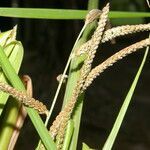Perennial from short rootstock. Culms robust, forming a dense tussock, erect, 1–2 m tall. Leaf sheaths compressed, usually papillose-hirsute at margins and summit; leaf blades linear, flat, stiff, 30–75 × 1–2.5 cm, margins serrate, apex acuminate; ligule 2–3 mm. Inflorescence axis 10–30 cm; racemes up to 20, 5–15 cm, ascending or drooping; spikelets paired, in 4 dense rows; rachis 0.5–1.5 mm wide, scabrous, glabrous or with a few setae. Spikelet brownish, obovate, 2.2–3 mm, acute; upper glume membranous, 3–5-veined, dorsally puberulous, margins fringed with short silky hairs above middle; lowerlemma resembling upper glume but glabrous; upper lemma brownish, as long as spikelet, coriaceous, finely punctulate-striate, subacute. Fl. and fr. summer–autumn. 2n = 40, 80.

